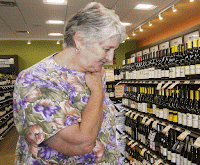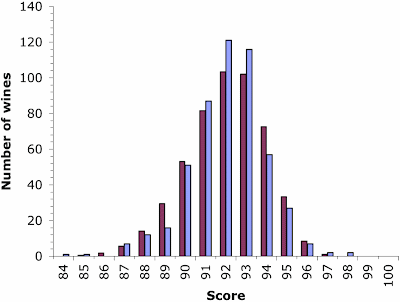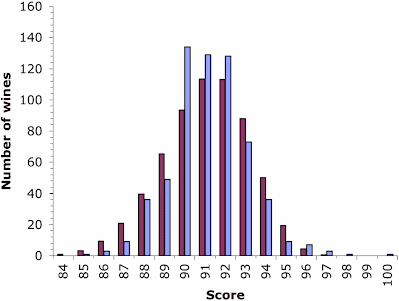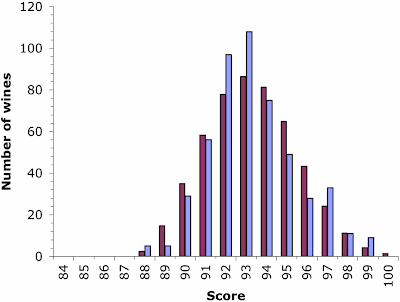These days, you use an app or a web page. Social interactions have moved in this direction during my lifetime — no longer do we look people in the eye, but we stare at an electronic screen, instead. How does anyone get married, under these circumstances?
Well, there seems to be several quite different ways wine recommendations can be achieved via computing, and I will look briefly at them here. They are not all equally successful (or even easily understood).
First, however, we need to consider what we are using the recommendation for. Am I just looking for a wine to add to my collection, to drink at some future (appropriate) time? If so, then a suggestion from a (suitable) wine commentator is probably what I need. Am I looking for a wine to drink with dinner tonight? In that case it is quite different, because I (presumably) would like to end up with a specific wine, that either goes with the food or impresses the pants off my host. It seems to me that we lump these two extremes together, along with everything in between; and this confuses the issue.
Moreover, there are several possible criteria for choosing a wine. We could, for example, focus on quality, or we could focus on suitability for the occasion, or we could focus simply on whether we actually like it. These criteria do not necessarily need to coincide in terms of choice, under any given circumstances, although it seems desirable that they should do so as often as possible.
The matter of pairing wine with food seems to be a particular bug-bear. At one extreme, it is perfectly simple. For example, if I am going to eat a light white fish in butter sauce, then a hearty red wine would mean that I can’t taste the fish at all. On the other hand, my wife and I have a Sicilian recipe, originally for swordfish but we use it for tuna — it has a lot of strong ingredients, like tomatoes and capers and celery, and I would never be able to taste a light white wine against it. Pairing does not have to be more complicated than this.
On the other hand, sometimes getting the tastes to pair nicely is more tricky. We also have a duck recipe, with which it is suggested that we pair a Pinot Noir. I could not find one in the house, the first time we tried it, so I chose something else. It was a nice wine; but alternating a sip of this wine with a mouthful of duck did not enhance either product. Next time, I made sure I had a Pinot Noir — and it was perfect.
Given the above considerations, there are basically only four types of information that can be used to recommend a wine:
- Quality — scores or descriptions
- Detailed oenological characteristics
- Similarity to your known wine preferences
- Similarity to other people’s preferences
All four of these fail, in one way or another. That does not surprise you, because otherwise we would already have a universal wine recommender by now. So, let’s look at them, one by one.
Quality, variously defined, has traditionally been at the heart of wine recommendations, since time immemorial. It is at the basis of all definitions of fine-wine regions, it is the basis of all wine scoring systems, and it usually is the basis of most wine writing. In the past, Baby Boomers preferred scores (It isn’t polite to point), but these days Millennials apparently prefer words (The importance of online reviews). For a range of suitable recommendation sites, consult: The top wine apps to help pick your bottles. Even putting aside the idea that most wines are never reviewed, and that many reviews might be fakes, the basic issue is still that wine commentators all have different opinions, many of which reek of unadulterated snobbery. As a result, the wine industry has a pretty atrocious reputation — trying to reach “normal people” seems to be an uphill battle (How did Australian beer slobs become wine drinkers?).
So, wine recommendations based on quality miss the basic point — most people care more about value for money than about quality per se. There are definitely web sites based on this idea of value, and they have been successful. However, they all cover geographically and temporally restricted locations. For example, I choose newly available wines based on value for money suggestions from local writers here in Sweden — if two of the three agree, then I am likely to try a bottle. This only works here, and it only works for the few weeks that the wines are available. This is not a general recommendation scheme.
The second recommendation approach is to break the thing being recommended down into each of its minute components, and then try to match those components to the recommendation required. For example, The Music Genome Project claims to be the most comprehensive analysis of music ever undertaken, treating it like a study of the genes in your own body. Your genes, inherited from your parents, act together to create yourself; and we therefore are very interested in studying them, to see how they work. The idea is to do the same thing for music, based on all of its acoustic elements; and the same can also be done for wine (eg. Tastry AI).
The basic problem here is that neither music nor wine exist for us outside of our own minds. That is, our ears detect the sound waves of music, but they then convert them into electrical signals, which they transmit to the brain. Thus, it is our brain that interprets the electrical signals, and calls some of them music and some of them cacophony. The same applies to taste. Atomizing music or wine into the basic components that exist before we hear or taste them deals only with the first part of the experience (Why wine is tasted with your brain, not your palate). The role of perception in food and wine evaluation cannot be over-estimated.
The third approach to recommendation is simply to get you to decide what you like (or want) and then find other products that seem to be similar (eg. My WineGenius). That is, you rate your experiences in some way (words or numbers), and this is used to provide you with new suggestions (these days, based on the computer techniques of artificial intelligence and machine learning). This approach suffers from the same problem as above, that our perceptions occur in our minds; and there are lots of extraneous things that can affect what our minds perceive. Different circumstances lead to different perceptions, so that time, place and prior information all play a role in what we think we like, on any given occasion (eg. The taste of wine can be influenced by music; How Brahms might make your wine taste better). What we liked last time is not necessarily the same as next time.
The fourth approach is somewhat similar to the third one, but instead is based on matching you to other people. That is, you all rate your experiences (using words or numbers), and these ratings are then used to match you to other similar people (once again, via artificial intelligence and machine learning). The recommendations then come from things that those other people rated highly but which you have not yet rated. Perhaps the most (in)famous example of this is movie recommendations from Netflix, but Amazon recommendations work the same way. So, naturally, this approach can be applied to wine (The path to Netflix-quality wine recommendations leads through the doors of perception).
This is sort of how marriages work (as mentioned above). You find someone whom you like, and then see how many things you have in common. The more you find, the better the relationship seems to work, long term. Now, obviously, this analogy breaks down pretty quickly, because married people have to change, in order to adapt to each other’s differences; and the more you adapt, the longer things seems to last. This does not apply to drinking wine, of course, since the wine completely fails to adapt to us. Nevertheless, people are prepared to have a go at this approach, for wine (eg. Clans: The intersection of AI/machine learning with behavioral science).
There are lots of different wine recommendation systems out there; and I have mentioned only a few specific ones here. The problem with all summaries of specific recommender systems is that they have a particular agenda — to sell you their particular recommender (and not any of the others). As such, they are very vague, being based on hyperbole rather than information.
So, should we remain optimistic about the idea of a general wine-recommendation system? Well, I still maintain that if we are likely to get one, then we would already have it by now. Sommeliers have been around for a very long time, and they may slowly be getting replaced by computerized systems. However, that does not make the recommendations any better (or worse). As for myself, I still prefer interacting with people rather than computers.






















